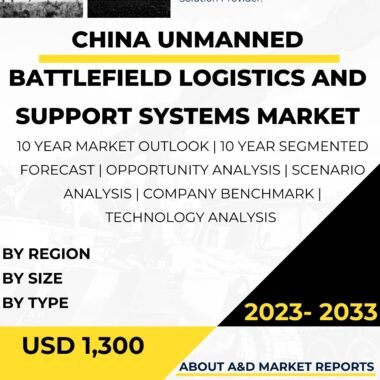Description
Unmanned battlefield logistics and support systems play a critical role in modern military operations, offering efficiency, safety, and versatility in supplying troops, maintaining equipment, and providing essential support on the battlefield. In Canada, unmanned systems have become an integral part of the Canadian Armed Forces (CAF) strategy, enhancing the country’s military capabilities and contributing to operational success. This article explores the importance of unmanned battlefield logistics and support systems in Canada, their history, types, technology, challenges, and their role in enhancing the CAF’s operational effectiveness.
The use of unmanned systems in battlefield logistics and support has evolved over the years in response to advancements in technology and changing military requirements. As early as World War I, Canada and other nations employed primitive unmanned vehicles for reconnaissance and supply tasks, providing valuable information and reducing the risks to human operators.
With the emergence of unmanned aerial vehicles (UAVs) or drones, the concept of unmanned systems expanded to include various battlefield logistics and support functions. UAVs are now widely used by the CAF to conduct surveillance, reconnaissance, intelligence gathering, and cargo transport in both domestic and international operations.
UAVs have proven invaluable in providing real-time intelligence to commanders, allowing them to make informed decisions and adapt to rapidly changing battlefield conditions. These unmanned systems offer enhanced situational awareness, covering areas that might be challenging to access or pose significant risks to manned aircraft or personnel.
In recent years, Canada has focused on the development and acquisition of advanced unmanned systems to enhance battlefield logistics and support capabilities. Some of the prominent unmanned systems used by the CAF include the RQ-21A Blackjack, the CU-170 Heron, and the SkyRanger R60.
The RQ-21A Blackjack is a tactical UAV system used for intelligence, surveillance, and reconnaissance (ISR) missions. This system provides real-time video and data feeds to ground stations, supporting ground troops and decision-making processes in various operational scenarios.
The CU-170 Heron is a medium-altitude, long-endurance (MALE) UAV that offers extended operational ranges and endurance. The Heron is used for a wide range of ISR missions, such as monitoring borders, conducting surveillance in conflict zones, and supporting peacekeeping operations.
The SkyRanger R60 is a compact and portable UAV designed for tactical applications. This system can be deployed quickly and is particularly useful for small-scale reconnaissance and surveillance tasks on the battlefield.
Unmanned ground vehicles (UGVs) are another category of unmanned systems used in battlefield logistics and support. UGVs can carry out a variety of tasks, including cargo transport, resupply missions, and equipment maintenance, reducing the risk to human operators and streamlining logistical operations.
One example of a UGV used by the CAF is the TITAN Unmanned Ground Vehicle. The TITAN is designed to transport heavy loads, providing a reliable and autonomous means of moving equipment, supplies, and casualties in challenging environments.
The integration of artificial intelligence (AI) and autonomous capabilities further enhances the effectiveness of unmanned battlefield logistics and support systems. AI-driven unmanned systems can adapt to changing conditions, make informed decisions, and operate with greater autonomy, reducing the need for direct human intervention and enabling more efficient logistics and support operations.
Challenges associated with unmanned battlefield logistics and support systems include the need for robust cybersecurity measures. As unmanned systems rely heavily on communication networks and data transmission, protecting the integrity and security of information becomes paramount. The CAF invests in cybersecurity solutions to safeguard its unmanned systems against potential threats and intrusions.
Another challenge is ensuring the interoperability and compatibility of different unmanned systems within the CAF’s network-centric environment. Coordination and information sharing between unmanned systems and manned platforms are critical for achieving seamless and effective joint operations.
Training and expertise are essential for operating and maintaining unmanned battlefield logistics and support systems. The CAF prioritizes training personnel to effectively utilize these advanced technologies, ensuring that operators and support personnel can deploy unmanned systems safely and efficiently.
Ethical considerations and compliance with international laws and regulations are vital aspects of using unmanned systems on the battlefield. Canada adheres to strict ethical guidelines and legal frameworks to ensure that unmanned systems are used responsibly and in accordance with international norms.
Unmanned battlefield logistics and support systems have demonstrated their effectiveness in various military operations, both in Canada and on the international stage. In domestic scenarios, unmanned systems have played crucial roles in disaster response and relief efforts, providing essential support and information to aid organizations and first responders.
Looking ahead, the future of unmanned battlefield logistics and support systems in Canada will likely see continued advancements in technology, capability, and integration. The development of swarming technologies, where multiple unmanned systems can work collaboratively to accomplish complex tasks, may further enhance the effectiveness of unmanned operations.
Additionally, increased miniaturization and advances in battery and power management technology will likely result in the development of smaller, more agile unmanned systems that can operate for extended periods without requiring frequent recharging or refueling.
In conclusion, unmanned battlefield logistics and support systems play a pivotal role in modern military operations, enhancing the CAF’s operational effectiveness and reducing risks to human operators. These advanced systems, including UAVs and UGVs, offer critical intelligence, surveillance, reconnaissance, and logistics capabilities on the battlefield.
Canada’s emphasis on the development and integration of unmanned systems demonstrates its commitment to leveraging technology to enhance military capabilities and improve operational efficiency. The ongoing research and acquisition of unmanned systems underscore Canada’s dedication to maintaining a modern and agile armed forces that can effectively respond to a wide range of operational challenges.
Unmanned systems will continue to be valuable assets in supporting the CAF’s military endeavors and humanitarian missions, promoting safety, effectiveness, and adaptability in diverse operational environments. As the landscape of modern warfare evolves, unmanned battlefield logistics and support systems will remain a cornerstone of Canada’s military strategy, ensuring that the country’s armed forces can fulfill their missions with precision, efficiency, and effectiveness.




